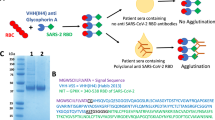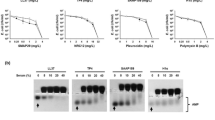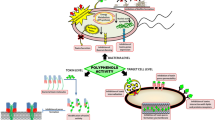Abstract
INVESTIGATIONS of the inhibition of haemagglutination have demonstrated the role of the penicilloyl group as the major antigenic determinant1. Coating of erythrocytes either with benzylpenicillin or with penicillenic acid leads to covalent bonding of penicilloyl haptene groups either by irreversible reaction of penicillenic acid with lysine ɛ-amine groups or by coupling involving the direct addition of the β-lactam carbonyl to lysine ammo residues of membranous proteins. According to Levine2 the former mechanism is more likely. Combination of penicillenic acid through disulphide linkages, as reported by De Week and Eisen3, has been attributed by Levine and Ovary4 to small numbers of penicilloyl groups in the penicillenate conjugates. However, such groups were not detected by De Weck1 and no cross-reactions were observed with anti-penicilloyl antisera. Occasional human sera are encountered in which inhibition is more effective with other degradation compounds of benzylpenicillin, namely, penamaldate, penilloate, penicillenate and penicilloate. Consequently, it is probable that other haptene specificities may be involved in the haemagglutination system, but their role is so far unestablished. In general, unaltered benzylpenicillin is a less effective inhibitor at equimolar concentrations. Because of this and the failure of benzylpenicillin to form stable covalent bonds with proteins it has been considered unlikely that the unaltered compound can function as an effective haptene.
This is a preview of subscription content, access via your institution
Access options
Subscribe to this journal
Receive 51 print issues and online access
$199.00 per year
only $3.90 per issue
Buy this article
- Purchase on Springer Link
- Instant access to full article PDF
Prices may be subject to local taxes which are calculated during checkout
Similar content being viewed by others
References
De Week, A. L., Intern. Arch. Allergy, 21, 20, 38 (1962).
Levine, B. B., J. Med. Pharm. Chem., 5, 1025 (1962).
De Weck, A. L., and Eisen, H. N., J. Exp. Med., 112, 1227 (1960).
Levine, B. B., and Ovary, Z., J. Exp. Med., 114, 875 (1961).
Watson, K. C., Joubert, S. M., and Bennett, M. A. E., Immunology, 4, 193 (1961).
Watson, K. C., Joubert, S. M., and Bennett, M. A. E., Immunology, 3, 1 (1960).
Josephson, A. S., J. Exp. Med., 111, 611 (1960).
Author information
Authors and Affiliations
Rights and permissions
About this article
Cite this article
WATSON, K. Inhibition of Haemagglutination by Benzylpenicillin adsorbed on Erythrocytes. Nature 210, 1180–1181 (1966). https://doi.org/10.1038/2101180a0
Issue Date:
DOI: https://doi.org/10.1038/2101180a0
Comments
By submitting a comment you agree to abide by our Terms and Community Guidelines. If you find something abusive or that does not comply with our terms or guidelines please flag it as inappropriate.



